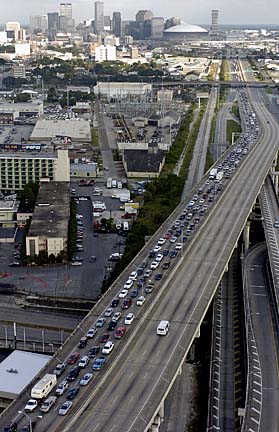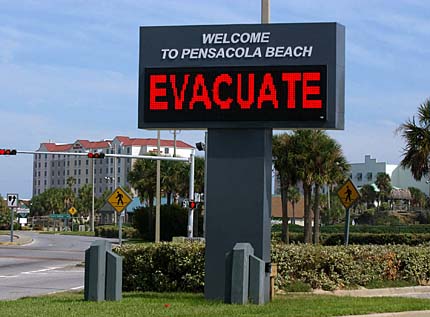

|
Hawaii guests trying
to get out of Big Easy
Being stranded in New Orleans is not the party some might think, especially when Hurricane Ivan is coming to town.
Four Hawaii residents found that out the hard way when they arrived in Louisiana yesterday. The National Jaycees Convention they had come to attend had been canceled while they were en route, and people were fleeing town while they checked into their hotel.
"Everyone is trying to evacuate the area," said Jon Nishihara, president of Hawaii Jaycees, in a telephone interview last night. "On TV, the mayor of New Orleans is advising all citizens and visitors to leave and we've been trying to get out, but we can't get a flight.
"So if we can't get a flight out (today) we're pretty much stuck here until the storm is over."
Nishihara said his delegation is not alone and that other convention attendees from all over the country are stuck because there are no flights out of town. Nishihara said, thankfully, their hotel is still open and they have somewhere to stay.
"We're going to try to make the best of it and have a hurricane party," he said.
The only chance for Hawaii delegates to fly out and make their connecting flight in Houston is if they could catch either a 6:30 or 11 flight this morning, New Orleans time. As of late last night, however, the four were still trying to find their way to the airport.
"We don't know if we can even get a taxi or shuttle to get out there to the airport," said Marcus Pang, Hawaii Jaycee Community Development vice president. "They plan to shut the airport down at noon so if we can't make it, we'll rough it out another day and try again."
Roughing it out may not be so bad, however. Although stores are closed with sandbags blocking the door, it appears Bourbon Street remains open to all those who still want a taste of cajun nightlife before Ivan blows into town.
"The bars and clubs and music places are still open," said Pang. "I guess nothing stops those guys."

|
As Ivan approaches,
towns deserted, roads
leading north clogged
NEW ORLEANS -- Some beach towns were deserted Wednesday and highways leading to higher ground were jammed as Hurricane Ivan roared toward the Gulf Coast with 140 mph winds.
Nearly 200 miles wide, Ivan could cause significant damage no matter where it strikes, as hurricane-force wind extended up to 105 miles out from the center. Hurricane warnings were posted along a 300-mile stretch from Grand Isle, La., across coastal Mississippi and Alabama to Apalachicola, Fla.
"We're leaving today. All this is going under," said a surfer Chuck Myers who was only taking pictures of the waves Wednesday morning at Gulf Shores. "We surfed it all day yesterday. It was glorious."
"This is a bad one and people need to get out," Mobile, Ala., Mayor Mike Dow said Wednesday on ABC's "Good Morning America."
Fleeing to safety was not an option for some people, especially in New Orleans, the below-sea-level city where more than 1.2 million were warned to get out of the metropolitan area.
"Got no place to go and no way to get there," said Latonya Hill, who waited out the storm Tuesday sitting on her stoop. Hill, 57, lives on a disability check and money she picks up cleaning houses or baby sitting.
"They say evacuate, but they don't say how I'm supposed to do that," Hill said. "If I can't walk it or get there on the bus, I don't go. I don't got a car. My daughter don't either."
No shelters had been set up in the city because of concerns about flooding and capacity, Mayor Ray Nagin said.
Those who could streamed inland in bumper-to-bumper traffic in an agonizingly slow exodus, spurred by dire warnings that the hurricane could overwhelm New Orleans with up to 20 feet of water.
However, Nagin said Wednesday that the evacuation had been going smoothly. "Of course we are trying to move a large number of people out of our city," he said on NBC's "Today." "We experienced gridlock on the highways. But for the most part it's subsided."
By daybreak in Fort Walton Beach, Fla., streets were deserted and businesses were boarded up.
At 8 a.m. EDT Wednesday, Ivan was centered about 180 miles south-southeast of the mouth of the Mississippi River and moving north-northwest at 12 mph. Forecasters said Ivan could bring a coastal storm surge of 10 to 16 feet, topped by large, battering waves.
Forecasters said Ivan, which killed at least 68 people in the Caribbean, could reach 160 mph and strengthen to a dangerous Category 5 by the time it blows ashore as early as Thursday somewhere along the Gulf Coast.
"Hopefully the house will still be here when we get back," said Tara Chandra, a doctor at Tulane University in New Orleans who packed up his car, moved plants indoors and tried to book a hotel room in Houston. Chandra said he wanted to ride out the storm, but his wife wanted to evacuate: "All the news reports are kind of freaking her out."
"I beg people on the coast: Do not ride this storm out," Mississippi Gov. Haley Barbour said, urging residents in other parts of the state to open their homes to relatives, friends and co-workers.
New Orleans, which sits largely below sea level, is particularly vulnerable to flooding, and Nagin was among the first to urge residents to get out while they can. The city's Louis Armstrong Airport was ordered closed Tuesday night.
Up to 10 feet below sea level in spots, New Orleans sits between the nearly half-mile-wide Mississippi River and Rhode Island-size Lake Pontchartrain, relying on a system of levees, canals and huge pumps to keep dry.
The city has not taken a major direct hit since Betsy in 1965, when an 8- to 10-foot storm surge submerged parts of the city in 7 feet of water. Betsy was blamed for 74 deaths in Louisiana, Mississippi and Florida.
Experts said Ivan could be worse, sending water pouring over the levees, flooding to the rooftops and turning streets into a toxic brew of raw sewage, gas and chemicals from nearby refineries.
The mayor said that he would "aggressively recommend" that people evacuate, but that it would difficult to order those who rely on public transportation to do so, since they would have no way to leave. In addition, he said 10,000 people were in town for conventions and there was nowhere for many of them to go except high floors in their hotels.
"They said get out, but I can't change my flight, so I figure I might as well enjoy myself," said George Senton, of Newark, N.J. "At least I'll have had some good coffee and some good music before it gets me."
Elsewhere along the Gulf Coast, thousands of residents, gamblers and tourists crowded northbound roads. Motels were booked as far north as Jackson, Miss., and Montgomery, Ala.
On Alabama's Dauphin Island, a narrow barrier island south of Mobile with many expensive homes built on stilts, Al Manning was boarding up his house for the first time in 11 years. Forecasters said the storm surge could completely swamp the island.
"It's been through three fairly strong hurricanes and one weak one," Manning said as he nailed a plywood board over a window Tuesday.
Mississippi regulators ordered a dozen casinos along the state's 75-mile-long coast to close.
Meanwhile, Tropical Storm Jeanne was threatening to turn into a hurricane Wednesday in the Caribbean as it approached Puerto Rico. At 8 a.m., it had wind of about 70 mph, just a few mph below hurricane strength, and was about 70 miles southeast of San Juan, Puerto Rico. Long-range forecasts showed it could be near Florida's east coast as early as the weekend.